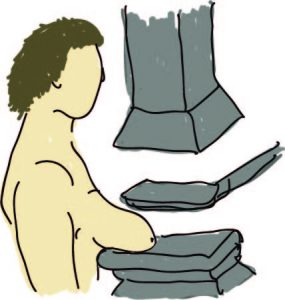30th September, 2018, Dr Chee L Khoo
There is no question that screening mammograms have led to a decline in late stage breast cancers. There have been a gradual decrease in breast cancer mortality, at least partly, due to the introduction of screening mammograms over the last 25 years. But screening mammograms are not perfect. In women with dense breast tissue, the sensitivity of mammogram decreases. In women with more than 75% breast parenchymal tissue, the sensitivity has been reported to be as low as 48%. And dense breast is fairly common – up to 2/3 of premenopausal women and up to 30% elderly women. If only we can improve the sensitivity of the mammogram. Can we?
Well, the issue isn’t as simple. Improving sensitivity means reducing false negative scans, right? Which means picking up more cancers and not missing too many. But picking up more by improving sensitivity may result in more false positives scans too. That is, picking many that are not cancers. False positives result in higher recall rates, higher biopsy rates and more patient anxiety. Further, picking up more may or may not translate to better mortality or morbidity figures.
A 2016 systematic review looked at studies comparing digital breast tomosynthesis (DBT), so-called 3D Mammogram plus full field digital mammogram (FFDM) with FFDM alone. 5 eligible studies were analysed. Two were from Europe (Oslo Tomosynthesis Trial & STORM) and 3 were from the US ((Destounis 2014 [23], Lourenco 2014 [24] and Friedewald 2014). The studies differ in their screening paradigms. The European studies generally had a two yearly recalls while the US studies were yearly recalls. Some studies had double reading when comparing 3D mammogram with FFDM. Most studies only have limited follow up making determination of sensitivities and specificity difficult.
Nonetheless, the two European studies observed higher cancer detection and invasive cancer detection rates using DBT + FFDM than FFDM alone. In the STORM study, false positive rates and recall rates were lower. Women were recalled if either reader reported a positive finding. In the OST, positive readings were presented to a consensus group and decision were made as to whether to recall the women. The false positive rates were lower pre-arbitration for DBT + FFDM compared with FFDM alone. DBT + FFDM was higher post arbitration compared with FFDM alone.
In the US studies which were retrospective studies, cancer detection rates were higher and there were less false positive and recall rates.
Radiation exposure rates were doubled if DBT and FFDM were performed separately. But using synthesised views from the DBT is now possible and therefore, radiation exposure concern is reduced.
Overall, the studies concluded that invasive cancer rate detection was higher using DBT + FFDM compared with FFDM alone. It also suggest that false positive and recall rates were also lower.
The value of 3D Mammogram is well illustrated in this case study.
Reference
Skaane P, Bandos AI, Gullien R, et al. Prospective trial comparing full-field digital mammography (FFDM) versus combined FFDM and tomosynthesis in a population-based screening programme using independent double reading with arbitration. Eur Radiol 2013;23:2061e71.
Skaane P, Bandos AI, Gullien R, et al. Comparison of digital mammography alone and digital mammography plus tomosynthesis in a population-based screening program. Radiology 2013;267:47e56.
Bernardi D, Caumo F, Macaskill P, et al. Effect of integrating 3D-mammography (digital breast tomosynthesis) with 2D-mammography on radiologists’ true-positive and false-positive detection in a population breast screening trial. Eur J Cancer 2014;50:1232e8.
Caumo F, Bernardi D, Ciatto S, et al. Incremental effect from integrating 3Dmammography
(tomosynthesis) with 2D-mammography: increased breast
cancer detection evident for screening centres in a population-based trial.
Breast 2014;23:76e80.
Ciatto S, Houssami N, Bernardi D, et al. Integration of 3D digital mammography with tomosynthesis for population breast-cancer screening (STORM): a prospective comparison study. Lancet Oncol 2013;14:583e9.
Houssami N, Macaskill P, Bernardi D, et al. Breast screening using 2Dmammography or integrating digital breast tomosynthesis (3D-mammography) for single-reading or double-reading – evidence to guide future
screening strategies. Eur J Cancer 2014;50:1799e807.
Destounis S, Arieno A, Morgan R. Initial experience with combination digital breast tomosynthesis plus full field digital mammography or full field digital mammography alone in the screening environment. J Clin Imaging Sci 2014;4:9.
Lourenco AP, Barry-Brooks M, Baird G, et al. Changes in recall type and patient treatment following implementation of screening digital breast tomosynthesis. Radiology 2014:140317. Sep 22: 140317
Friedewald SM, Rafferty EA, Rose SL, et al. Breast cancer screening using tomosynthesis in combination with digital mammography. J Am Med Assoc 2014;311:2499e507.
Robert Hodgson a , Sylvia H. Heywang-Kobrunner € b , Susan C. Harvey c , Mary Edwards a , Javed Shaikh a , Mick Arber a , Julie Glanville. Systematic review of 3D mammography for breast cancer screening. The Breast 27 (2016) 52 – 61
